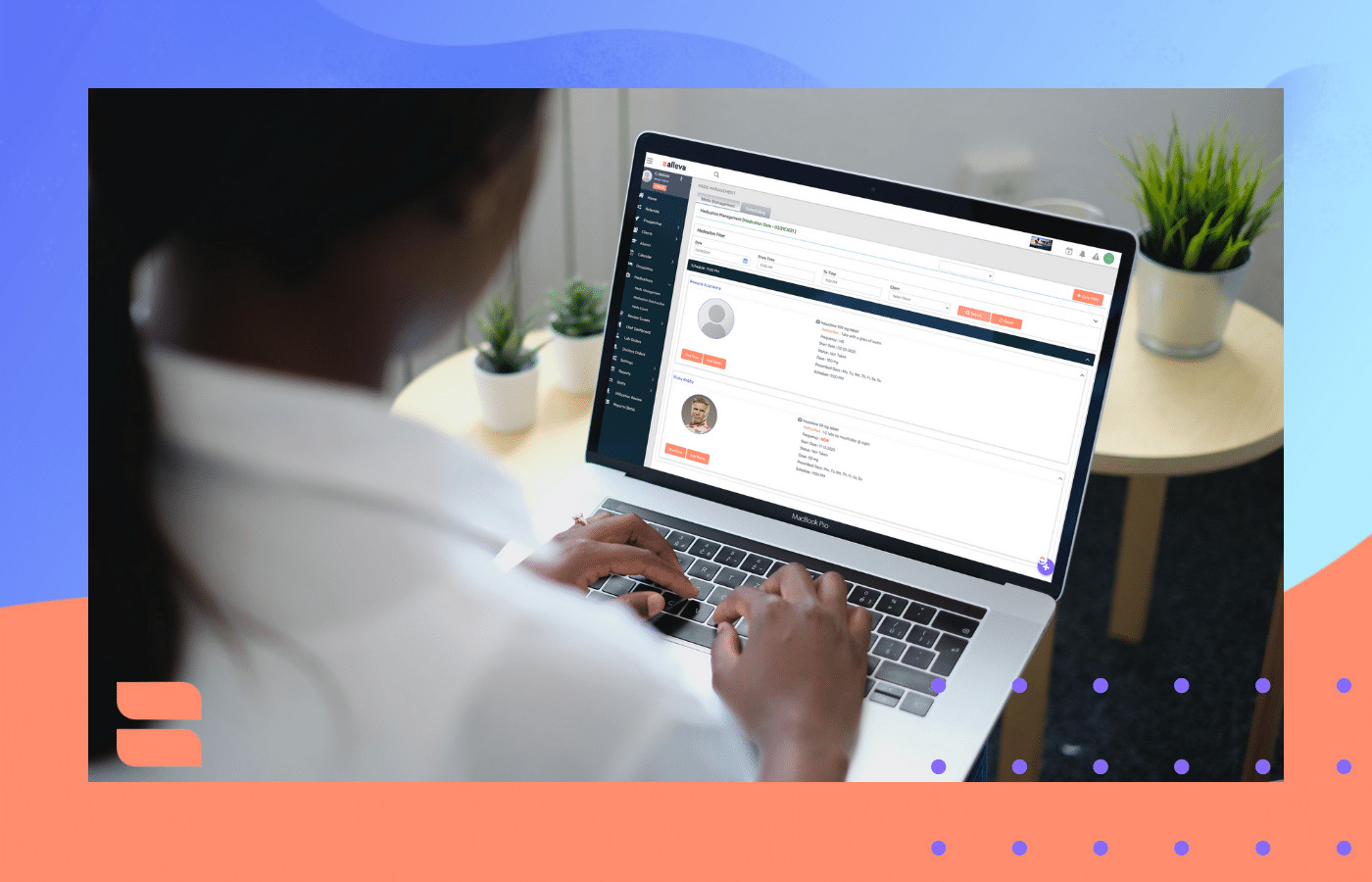Trust Alleva to optimize your task management system and allow you to dedicate more time to serving those in your care.
The holiday season, known for its mirth and festivities, can often be stressful, leading to an increase in mental health challenges. Nearly 38% of people experience elevated stress levels during this period, contributing to physical illness, depression, anxiety, among others.
You've signed on. You're part of the team. Now what?
It's time to get to know us better, and lucky for you, we're an open book. (Read more about us here.)
You can rely on Alleva for all your technological needs. We're proud of what we've built to support the people on the front lines of behavioral health. When charting is quick and easy, you can focus your time and effort on providing the best possible care. With better tools for compliance and reporting, you can feel confident in your operation's growth and success.
We're proud to offer the latest and greatest technology to make your life easier and help your company to thrive!
Here are some key features you'll want to get to know right away:
- Say Hello to Tasks
- "Tasks" is our compliance driver. It's an automated list that displays your To-Dos so you know where to dive in.
- Learn more about your dashboard's “My Tasks” widget here.
- Say Hello to Insights
- Make your EMR data work for you. You can track your program’s progress and treatment efficacy with advanced, real-time data. Visual graphs and easy reporting features will help you make better business decisions.
- Learn how to see the metrics you care about here.
- Say Hello to our Client/Family Portal
- Discover seamless care coordination from anywhere.
- Clients and their loved ones can send secure messages, view calendars, join telehealth sessions, sign consents, and more!
- Send mass announcements to notify alums of upcoming events and keep family members in the loop.
- Say Hello to the Alleva Connect App
- Say Hello to Telehealth
- You can access built-in, HIPAA-compliant telehealth from the Scheduler with one click.
- All invited parties will be automatically notified of meeting times and provided links to join.
Fun Fact: A study found that if clients get a text message with a link to the event fifteen minutes before it starts, they're 50% more likely to attend. Alleva offers a built-in text reminder feature that automatically pings invitees one day before, one hour prior, and fifteen minutes before the event.
- Say Hello to Medications
- Our pharmacy-integrated medication management tool saves time and keeps track of inventory to optimize your workflows.
But wait—there's more! Learn all the ins and outs of our platform at your convenience with Alleva University. You'll have 24/7 access to instructional videos and step-by-step instructions on key topics and features. You can even get Alleva certified.
Thanks again for joining the Alleva team. We're excited to get to know you better, too!
Historically, mental health and addiction treatment has been viewed as something completely different from standard health care. When someone has physical pain, we encourage them to see a doctor, to get medication and the treatment they need so that they can begin to heal. However, we often don’t know how to react when someone discloses emotional pain or addictive behavior.
There seems to be a disconnect in our understanding of the source of mental illness and physical illness. The brain is a complex and powerful organ but it often goes unexamined when trying to help someone who expresses feelings of depression, anxiety, and other ailments that are neurologically based.
In truth, mental illness and physical illness are just illnesses. They both affect us in similar ways and have been found to have effective treatments. Recent developments in technology and science have allowed researchers to better understand the biochemistry and inner workings of the brain and have even allowed them to map out certain processes in the brain.
These advances allow treatment for mental illness and addiction to be on par with traditional medical practices. By merging the two, the cultural view shifts, and mental health is perceived as essential to physical health. There’s no “one size fits all” treatment. Treatment options can include:
- Psychotherapy.
- Medication.
- Hospitalization.
- Support Group.
- Complementary & Alternative Medicine.
- Self Help Plan.
- Peer Support.
Dr. John V. Campo, chair of the Department of Psychiatry and Behavioral Health at Ohio State University explains “Psychiatric drugs haven’t improved for decades. So researchers are scouring the brain for leads. Proven regimens for treating common mental disorders and addictions are aiding the ‘cure’ rate and boosting public acceptance that such care works."
"Modern practices have the potential to improve public health and, perhaps equally important, engage families more actively in the care of individuals suffering from mental disorders and addictions."
Dr. John V. Campo
As research and development expand, and cultural attitudes evolve, more effective treatment options will be available for those in need. Trying to tell the difference between what expected behaviors are and what might be the signs of a mental health condition isn't always easy, but identifying a problem early can help lead to the best outcome.
Many people have been turning towards Outdoor Wilderness Therapy programs in recent years. They prove an effective approach to treatment and offer a unique experience for many seeking outside-the-box treatment plans. But how does this work, and what can a participant expect?
“Go outside”
A phrase parents and guardians may be sick of saying at this point. But for those whose adolescents and young adults struggle with mental health, behavioral health, and substance abuse, this phrase takes on a new meaning. Outdoor Wilderness Therapy offers prolonged care through a group setting, ensuring that loved ones are safe and in good hands while also experiencing the wilderness and preserving a sense of adventure.
Researchers are working to provide clinical evidence of the effectiveness of outdoor and adventure therapy, and the results are promising. In a study commissioned by Redcliff Ascent, Dr. Steven Aldana cited that “91.4% experienced clinically significant improvement.” This study found the rate of recovery for Outdoor Wilderness Therapy programs to be twice that of other treatment methods.
This outdoor approach has been greatly effective, but it is important to know what this type of treatment really is. Wilderness Therapy is more than just the stereotypical campfire songs and s’mores. So, how are Wilderness therapies conducted?
Models
Two general models characterize the approaches to Wilderness Therapy- Contained and Continuous Flow. The contained flow model involves the same group of clients and guides living with and working together for up to three weeks during wilderness expeditions. In this model, the staff includes trained therapists and guides paired with a group of clients based on an assessment of the clients’ needs, concerns, and diagnoses.
On the other hand, the continuous flow model focuses on a rotation of therapy clients and staff members revolving around the readiness for discharge based on the therapeutic progress of clients. This method is similar to groups in psychiatric settings wherein the group continues to meet on a consistent basis, while participants in the group change over time as they make progress. The time frame for continuous flow groups may depend on the program, but typically lasts up to eight weeks. To promote safe care practices for staff, the continuous care model uses a rotation schedule of a number of days or weeks on and days or weeks off.
Licensed therapists work with clients and staff in both contained and continuous flow models. Sessions are conducted either on-site (nomadically) or at “base camps” depending on how expeditions are conducted. Both contained and continuous flow models rely on patients’ interactions with each other and the wilderness to support and enhance their self-esteem, emotional regulation, positive mindsets, and communication skills.
Family Follow Through
A potentially overlooked portion of Wilderness Therapy is the necessary involvement of family or caregivers. While clients address their personal presenting concerns, these concerns often have roots in family relationships. In order for clients to make lasting progress, their loved ones must learn to make home a place to support the lasting care of the client through therapeutic intervention.
Often, clients cannot maintain positive changes unless their support system helps reinforce the changes made. This is especially true for the adolescent and young adult demographic who primarily frequent Wilderness Therapy.
Difficulties
While evidence grows in support of Wilderness Therapy, challenges persist with funding, communication, and documentation in this outdoor setting.
As with any therapeutic approach, funding may present a concern for practitioners, clients, families, and funding agencies. Families may find these programs quite difficult to afford if they are not covered by traditional insurance plans. Grants and scholarships may exist for these programs. However, acceptance for such funding options may be competitive.
In addition, a common concern for therapy is the use of remote treatment teams to provide services. Wilderness Therapy presents the unique challenge of the treatment team being scattered throughout wilderness settings and having to provide for both the treatment and physical needs of patients. Consequently, therapists and expedition staff must stay in frequent communication about the strategies used in sessions and on the expeditions.
Finally, the documentation of accurate records of client progress help justify the effectiveness of Wilderness Therapy. Documentation is critical because it helps assure that the methods of treatment on these expeditions are empirically based and effective.
The Solution
Although it may not seem so, advanced technology platforms can eliminate all of these concerns. Wilderness programs that have partnered with an EMR platform, such as Alleva, find it easier to keep track of clients, write and upload notes, engage with the team via the communication log, and access digital copies of all important documents.
Through our commitment to being the friendliest EMR on the market, Alleva is changing the Wilderness Therapy game. Our versatility, state of the art cloud technology, and exceptional customer service make us the top choice for care providers and behavioral health facilities, no matter where they are located. Sleep soundly knowing that with Alleva on your team, you can get back to doing what you do best. Reach out today, and request a free demo!
Clearfork Academy is a Christ-centered residential treatment program for youth between the ages of 13 and 18 years old who struggle with substance abuse or addiction and the accompanying mental health and behavioral issues. They began using Alleva EMR when they first opened their two facilities in Texas but, after a while, parted ways. Then they "came back home" to Alleva. Listen to Austin Davis talk about the growth he's seen in Alleva over the years and how using the platform has helped their company succeed.
Alleva's Electronic Medical Records software solution offers the latest technology to therapists, improves the quality of their work, and relieves stress. Our intuitive, user-friendly platform eases the workflow for those providing care, so they have more time to do what they do best--serving their clients and saving lives.
Alleva's Insights feature helped Clearfork Academy to make better business decisions as their company grew. With advanced, real-time data, our clients are able to track their health center’s progress and efficiency. Customized charts make reporting a breeze. We help behavioral health clinics to meet their strategic business goals.
Let us walk you through it with a quick, hassle-free demo.

No more headaches. No more hassles.
Alleva Insights is easy and automated.
Say hello to solutions. helloalleva.com
Behavioral Health facilities using Alleva's telehealth feature are able to reach thousands of isolated clients in despair using their built-in Zoom Video technology.
LAGUNA NIGUEL, Calif. (PRWEB) May 20, 2022-- In the wake of COVID-19, the U.S. not only faces a devastating death toll of over 980,000 lives lost from the virus but a staggering number of over 100,000 additional “deaths of despair” from alcohol abuse, drug overdoses, and suicide. This is a 28.5% increase in overdose cases from before the pandemic. With the burden on behavioral health facilities continuing to build, Alleva teamed up with Zoom Video Communications, Inc. in 2017 to offer a comprehensive telehealth solution that enables behavioral healthcare companies to meet HIPAA compliance requirements while delivering exceptional care.
Even before the pandemic, Alleva recognized the utility of Zoom’s unified communications platform and its application for healthcare facilities. Since its implementation, clinicians have been able to stay in contact with their clients who are unable to attend in-person sessions and those who prefer remote treatment. Before Covid, Alleva's customers averaged around 60 thousand telehealth minutes a month, but in April of 2020, and the onset of pandemic restrictions, that number jumped to almost 2 million minutes a month. Even as Covid risks have diminished, telehealth has not tapered off.
“The demand for telehealth shows no signs of slowing,” said Paul Magnaghi, Global ISV Program Leader, Zoom. “It’s crucial to provide a simple, frictionless, and secure experience for everyone involved–from provider to patient. Our platform incorporates security controls to help enable customers to satisfy the HIPAA Security Rule. We are pleased to have Alleva join Zoom’s ISV Partner Program and provide a simple and quick way for people to get connected to the care they need.” With the integration of Zoom’s convenient technology and the Alleva EMR, treatment centers can sync calendar appointments, and send invitations and reminders via texts directly to the Alleva app on their client’s cellphone, all while enabling HIPPA compliance.
Steven McCall, CEO of Alleva, said, "The fact that we were among the first EMR platforms to add the telehealth feature back in 2017 meant that we were agile and responsive when clinicians' circumstances and needs changed. Alleva is all about offering the latest technology and making life easier for caregivers.”
Alleva’s telehealth feature has allowed substance abuse and behavioral specialists to connect to their clients during increasingly challenging times. With options for individual, group, family, and admissions sessions, the telehealth feature allows people to connect effortlessly through digital means, with room for continued innovation. Moving forward, Alleva is looking to expand their solutions to further streamline communication and connect substance abuse specialists to those who need it.
For more information about Alleva, its built-in telehealth solutions, and how its solutions are shaping the behavioral healthcare industry, visit HelloAlleva.com.
About Alleva
Alleva provides world-class software to the behavioral health industry. Made up of a team of licensed therapists, industry professionals, and experienced software developers, they seek to use their industry background and passion to help the helpers give better care by providing them with supportive technology.
While new technology or procedure changes in the workplace can be intimidating, switching from paper records to electronic health records is essential in today's behavioral health market. Many clinicians resist change, even if it promises to make the day-to-day feel easier. Many people think, “If it’s not broke, don’t fix it,” when asked to update their charting procedures. But if time is wasted trying to decipher handwriting or figuring out which antiquated symbol to click to view the most recent treatment plan, then an EMR will definitely simplify the process and increase efficiency.
With the right software system, one that is intuitive and handles tasks seamlessly, productivity improves and clinicians discover that they have more time to do what matters most--caring for those they serve.
In the behavioral health space, there are a few competing software programs. It is important to make sure that the time and effort spent adopting a new system is worthwhile. When looking for the EMR that best fits your addiction recovery facility, pay attention to how the system will help you achieve your clinic's goals and what kind of support is in place to see the implementation through.
What is EMR software?
EMR is Electronic Medical Records, sometimes referred to as EHR or Electronic Health Records. It is a major decision to choose what EMR to use and there are many factors to consider: cost, functionality, training, support, and compliance. The short-term time commitment cost of learning a new system is significantly outweighed by the benefits experienced by counselors able to document and track their clients' history more easily and efficiently.
Choose a system that helps to track patient progress and challenges, and updates other team members on patient engagement, seamlessly. Consider the following criteria to determine if the addiction treatment EMR software is right for your facility:
Is it customizable?
It is important to use software that is designed specifically for your industry. Behavioral health treatment centers need an EMR that is secure, makes documentation easy and helps with reporting and compliance. With a task-based system, the clinician is less likely to skip an essential step in the record-keeping process.
Is it collaborative?
Adopting a new EMR is generally done with the purpose of streamlining processes that are already present. Letting staff know that this is intended to be less work and save time is imperative. Giving the people who work with the system the most a say in what they need from an EMR can also allow this to feel like a collective decision. When a system is secure and cloud-based, information can be shared easily. Telehealth features facilitate communication and should be a requirement.
Is it easy to use?
Upgrading to a user-friendly EMR can take some of the paperwork burdens off of therapists. Clinicians who spend exorbitant amounts of time documenting or fighting with old systems are more likely to feel stressed at work. The longer this continues, the more likely it is that clinicians will burn out. Here are some ways that an EMR can alleviate this struggle and help therapists do more of what they love to do.
- Spend Less Time Charting - Being able to type notes quickly and have a system that flows smoothly just saves time. A thoughtful setup simplifies processes.
- Find Information Easily - When you need to dig around an old system or binder, it can take forever to find a specific record. With a system built to organize client information logically, counselors spend more time reading the actual data instead of clicking around.
- Keep Track of Progress- Do screening assessments electronically and see how scores change over time. It makes treatment planning and assessing progress and goals so much easier to understand.
EMR Made for Therapists by Therapists
As a clinician, your needs are a priority. When time is wasted on an incompatible EMR, paper charts, or separate excel sheets to track client information, then there is a risk of burnout, the quality of treatment suffers, and a clinic's ability to meet its goals is at risk.
When an EMR is designed specifically for therapists and not just as an afterthought or an add-on option, our needs are truly addressed. An EMR platform that offers everything in one place makes the most sense.
Alleva's mission is to bring technology to therapists that actually improve their quality of work and takes the stress out of the work. Alleva works to make a system that is intuitive to your personal needs. If you are interested in a hassle-free demo or to learn more, reach out today.
The behavioral health industry is growing thanks to an increased acceptance of mental health treatment. Digital solutions like EMRs are perfectly poised to improve the industry both for patients and clinicians. Alleva is ready to help behavioral health facilities in 2021.
Behavioral Health Market Growth
Behavioral health doesn’t always get the attention it deserves because it focuses on mental health and wellbeing rather than physical health conditions for which we have medicinal treatments. It’s not as simple to treat depression or substance abuse because it requires psychological intervention, whereas heart disease doesn’t. This distinction has made all the conditions surrounding behavioral health—funding, research, authorization—different.
The problem with this distinction is that behavioral health conditions are often tied to physical health conditions. We are learning that physical health conditions affect a person’s mental health and well-being, and a person’s mental health can lead them to develop physical health conditions. This is why addressing behavioral health is incredibly important, and why providing quality support for treatment centers can improve our society’s well-being.
Public awareness and acceptance of mental health treatment make behavioral health more accessible, thus increasing the market size. Experts estimate the behavioral health market will be worth around $240 billion by 2026. Due to the amount of money being poured into the industry, many companies will come and go. Only the ones that provide quality care and support will stay relevant.
Improving Behavioral Health Outcomes
But not everything is about money. Because we are talking about behavioral health, the most important aspect of this growth is: how will this affect patients and clinicians?
There are specific goals for the behavioral health industry that are directly tied to improving the lives of their patients and making clinicians’ work easier. One of the ways in which the industry is working to make mental health more accessible is through the increased attention toward digital tools and solutions. During the pandemic, a lot of people experienced mental health symptoms that needed immediate attention, but social distancing guidelines prevented them from addressing those concerns by going to a treatment center. Telehealth and other digital tools were imperative during this time of need and will continue to grow as people realize the power these digital solutions have to help treat behavioral health concerns.
One of the best digital tools to help behavioral health management is electronic medical records (EMR). EMRs help improve communication between patients and healthcare providers, increasing the efficacy and productivity of treatment centers. Alleva’s EMR even includes telehealth options through video conferencing, making communication and scheduling even more effortless. At the end of the day, behavioral health management software like EMR helps treatment centers reduce costs related to substance abuse and other behavioral health concerns.
Challenges for Clinicians
An important part of improving mental health outcomes and increasing the effectiveness of behavioral health is by helping clinicians. The industry can help clinicians by educating them on ways to better measure behavioral health outcomes. Once clinicians understand what they are measuring and how they should define measurement-based care, they’ll be much more prepared to see what that would look like at the level of their treatment center but also at the individual level.
We must also keep in mind that clinicians are also prone to suffer from distress, especially during a pandemic where many people are in a desperate search for care and treatment. Clinicians are facing more patients, more meetings, more forms. And they’ve seen the struggle first-hand, some of them working from home, dealing with family members who may have been infected with COVID-19, and other stressors that come from balancing work and home life. As the behavioral health market grows, we must do our best to help clinicians with their increased workload.
One simple solution to help clinicians is to help establish digital tools like EMR in behavioral health facilities. EMRs help reduce paperwork and organize data. Clinicians can easily review information without having to go through mountains of paperwork. EMRs also make scheduling easier, and with virtual appointments, clinicians can see more patients, give them better quality care, and not feel the burnout that comes from juggling many patients in person. Clinicians can easily communicate with patients and share their insights to help keep their patients healthy while avoiding the distress of mental health work during the pandemic.
Alleva is Ready for 2021
As the behavioral health industry grows during the next few years, digital solutions will be necessary to make the workload manageable. Our friendly EMR helps with scheduling, charts, medication management, and gives you data in easy-to-read formats. And if you ever need to contact a patient, our video conferencing feature lets you hold appointments virtually.
2021 will be a busy year for behavioral health providers. Let us make it easier.
If you’d like to learn more, schedule a demo for Alleva and see how we help the helpers.
Even before the spread of COVID-19 forced millions of people around the world to isolate, the decline of human contact in our digital world was taking a toll. In the great debate about the merits and difficulties of a world dependent on technology, the jury is still out.
In some ways, we may fault technology for our culture’s rampant obsession with status, or the resulting depression and even addiction in the younger generations. In other ways, we praise it for making our lives easier, for making information available to the masses, and for its ability to connect us with others across the globe.
While we may agree with the risks of allowing technology such a vital place in our lives, we have all, in some way or another, cosigned the idea that through technology, we can improve how we communicate and connect with each other. Some technology, like video conferencing, brings people together and breaks through the barriers of isolation.
The Need for Human Connection
Since the dawn of humanity, we have needed connection with others of our kind, just as much as we needed food, water, or shelter. This is because, in many ways, banding together was our ticket to successfully meeting all other needs. As evidenced by early cave drawings all the way to today’s obsession with social media, we’ve long felt convinced of our need to communicate important messages, share about dangers on the horizon and even to celebrate successes with one another. Although the medium has changed over time, the fundamental service that these platforms appear to provide remains the same.
In the years since those early attempts at human connection, our society was on a path towards individualism, and as a whole becoming lonelier and more and more isolated from one another. Tricked time and time again by a consumerist mindset that told us that we are always “only 3 easy payments of $19.99” away from happiness, we’ve continually failed to learn our lesson. With the advent of the internet, we fared no better.
In his poignant discussion of the root causes of depression, Johann Hari points out that we are drawn to these manufactured forms of connection because at first, we believe that they are the real thing. However, no matter the number of emoji’s, gifs, or iMessages sent with special effects, communication online fails to measure up to the real thing, and only leaves us clamoring for our next ‘fix’.
“Only through our connectedness to others can we really know and enhance the self. And only through working on the self can we begin to enhance our connectedness to others.” ― Harriet Lerner
What Does This Mean for Clinicians?
Recent research reveals that the average person checks their phone 96 times per day or roughly every 10 minutes, and spend nearly half their day listening to, watching, reading, or otherwise consuming media. The Behavioral Health Industry is not immune to these societal changes. Although the therapy room may be one of the last frontiers where two individuals connect with one another for an extended length of time, uninterrupted, the battle for such a structure and even mandates for concurrent documentation appears to threaten this practice.
In some ways, clinicians are expected to provide a remedy for this lack of human connection, as well as a model for the path forward. It is crucial to this task to consider both the role of technology in both fostering and hindering human connection, and to discover the balance between consuming the content available to us and engaging with the people in front of us.
True, because of technology, we are aided in our ability to get tasks done more quickly and connect with others across the globe, but we must not neglect our connection to the natural world. For many reasons, this is why wilderness therapy has been so successful, in that it helps you retain your connection with the world around you.
Partnering with Alleva
At this time in history, we are navigating two worlds: the physical and the virtual. It is altogether vital to remember which one fosters true, fulfilling, human connection, and that which is only masquerading as such. Technology is important, but only when we remember its true purpose, to aid the lives of those behind the screen.
At Alleva, we are all about harnessing technology that helps you get back to what you do best- providing authentic, in-the-moment care. From our intuitive design and easy-to-use templates, with HIPAA-compliant communication logs, and tasks and notifications all in one place, spend less time stressing out over the tediousness of record management and invest your time instead back to the clients who have sought you out for treatment.
Quickly access and edit client notes, create individualized treatment plans based on Wiley Treatment Planners best practices, and assign the corresponding homework. With Alleva, you are able to deliver the same high-quality, individualized treatment that your clients have come to expect. Have your technology work for you, not the other way around. Less headache, more connection.
Customer Service  (877) 425-5382
(877) 425-5382
Copyright 2019 - Alleva Corp. All Rights Reserved.
Copyright 2019 - Alleva Corp. All Rights Reserved.
Copyright 2019 - Alleva Corp. All Rights Reserved.










 (877) 425-5382
(877) 425-5382